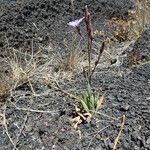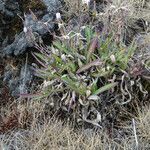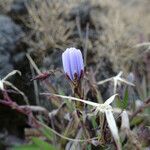Perennial herb, up to 1 m high; plant with milky latex. Leaves basally and along lower part of stem, sessile; blade of basal leaves linear or narrowly elliptic, up to 150 x 10 mm, apex acuminate, margins entire, irregularly dentate or runcinate-pinnatifid; blade of stem leaves linear, margins entire, base amplexicaul, auriculate, auricles triangular. Heads ligulate, many in lax panicle. Involucre ± 10 x 2 mm, increasing up to ± 18 x 4 mm in fruiting; involucral bracts in several series, imbricate. Flowers: white or bluish, very rarely yellow; Aug.-Mar. Fruit with cypsela dark brown or black, oblong, compressed, up to 6 x 2 mm, tapering to beak, with median rib on each face and marginal wings, transversely wrinkled; beak shorter than body of cypsela. Pappus of many yellowish white, barbellate bristles.
Glabrous, perennial herb, up to 1 m high, with milky latex, flowering shoots much-branched upwards. Leaves: basal leaves rosulate, sessile, narrowly lanceolate, entire or remotely denticulate to runcinate, bases semi-amplexicaul; cauline leaves lanceolate-acuminate, entire, amplexicaul, auriculate, glabrous or lower surface sparsely hispid. Capitula ligulate, many in lax panicle; involucre ± 15 mm long. Florets strap-shaped, blue-purplish or white, rarely yellow. Flowering time Sept.-Jan. Pappus of many barbellate bristles. Cypselae dark brown to black, flattened ellipsoid, broadly margined, with median rib on each face and wrinkled, tapering to short beak.
A glabrous glaucous perennial herb up to 1 m tall, stems much branched from the base and spreading, sparsely leafy, often with several leaf rosettes from a single crown. Radical leaves up to 15 x 1 cm, acuminate, margins entire, irregularly toothed or runcinate-pinnatifid, stem leaves lanceolate-acuminate, entire, amplexicaul, sagittate-auriculate. Heads many in a lax panicle. Involucre c. 15 x 4 mm. Flowers white or bluish, very rarely yellow. Achenes c. 5.5 mm with 2 mm beak, oblong, tapering sharply to the beak, strongly compressed, obscurely ribbed, margins broad, thickened, transversely wrinkled, blackish.
Leaves contemporaneous with the flowers, sessile membranous glabrous, or lower surface sparsely hispid with midrib and main nerves glandular-setose, entire or remotely denticulate, 8–20 x 0.3–1.6 cm., ± narrowly lanceolate, undivided to ± runcinate with lateral lobes up to c. 1.5 cm. long, bases semi-amplexicaul in basal leaves to sagittate-auriculate in cauline leaves, auricle lobes up to c. 2 cm. long and very narrowly triangular.
Achenes dark-brown to black 4.5–8.5 x 1.25–2 mm. including a 1.5–2.5 mm. long paler-coloured beak, flattened-ellipsoid, broadly margined, narrowly 1-ribbed on each face, hispidulous or glabrous; pappus several-seriate, of persistent white to yellowish-white barbellate setae 6–7 mm. long.
Synflorescence laxly or congested paniculate, rarely somewhat racemose; branches usually c. 8–10 cm. long and diffusely subdivided, or up to c. 25 cm. long ascending and sparsely or much subdivided, glabrous, bracteate; bracts leaf-like, narrowly triangular, sagittate-auriculate.
A herb. It has milky juice. It can grow 2.4 m high. There are only a few leaves. These can be on the base of the stems. They are narrow and the edges are entire. The leaves are 5 cm long by 3 cm wide. The flower heads are very narrow. They are blue, white or yellow.
Perennial herb, up to 1 m high. Cauline leaves auriculate. Involucre ±15 mm long. Achenes 5.5 mm broad with median rib on each face and marginal wings; beak shorter than body of achene. Flowers white or bluish, very rarely yellow.
Phyllaries glabrous, sometimes guttulate, green and often purple-edged or spotted; outer phyllaries 2–6 mm. long, lanceolate; the innermost up to c. 17 mm. long, lanceolate; margins becoming involute except near the apex.
Capitula numerous, stalked, solitary or loosely aggregated; involucres 8–10 x 1.5–2 mm. at time of flowering, increasing to c. 18 x 4 mm. in fruiting capitula, cylindric becoming narrowly conical in fruit.
Florets 4–14 per capitulum; corollas blue purplish orwhite, less often yellow, 0–17 mm. long, tube tufted-setulose near the throat; ligules c. 6–11 x 2 mm., oblanceolate-lorate, glabrous.
Stems solitary, or proliferating at the rootcrown, branched above, glabrous or setulose, glaucous, scattered leafy or leaves ± crowded on the lower stem, sometimes rosulate.
An erect perennial herb up to 1 (1.5) m. tall, with a long thick semi-woody taproot.



